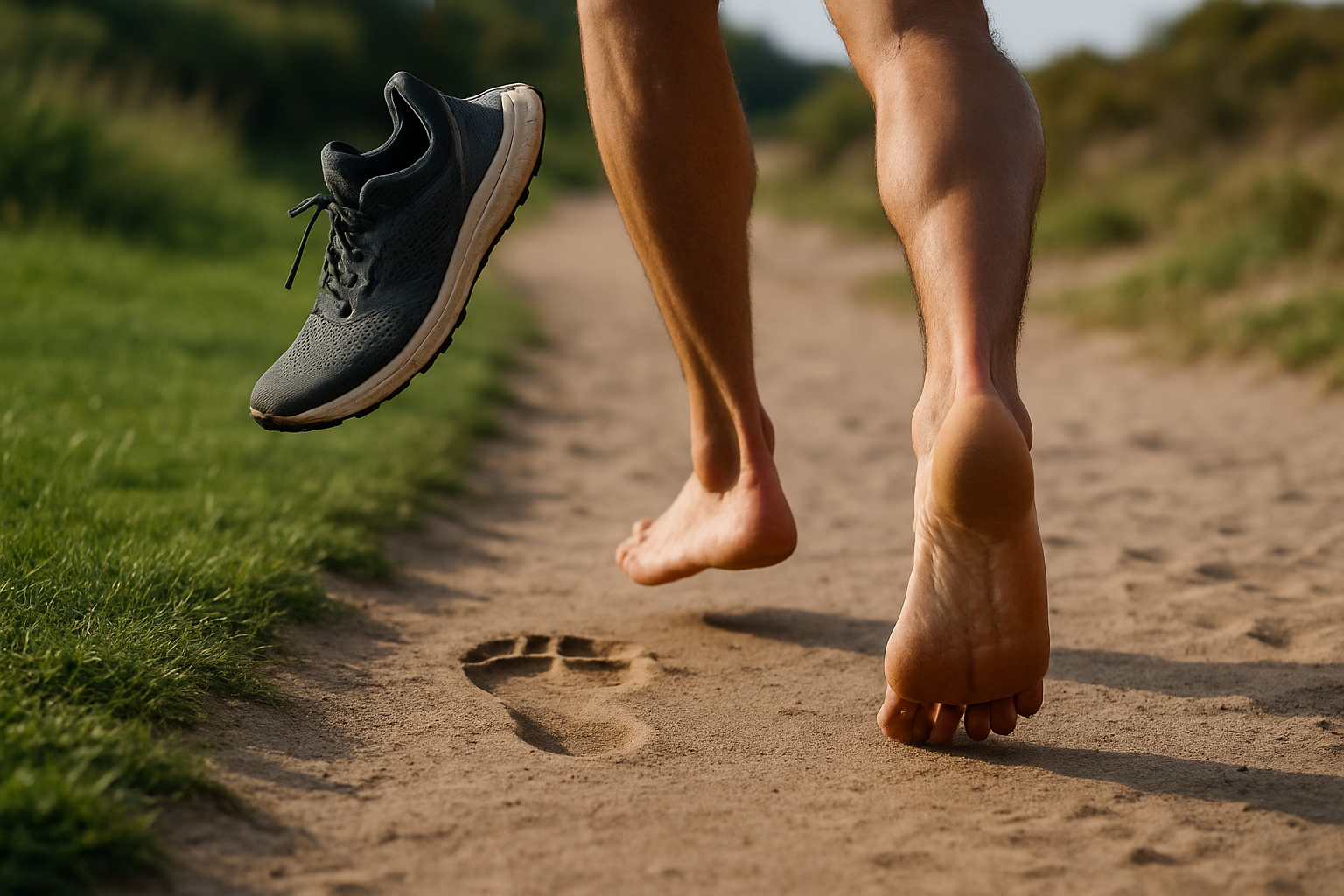Biomechanics of Barefoot Running: Rediscovering Nature's Design
In a world dominated by high-tech running shoes, a quiet revolution is taking place. Runners are shedding their cushioned soles and embracing the ancient art of barefoot running. This practice, rooted in our evolutionary past, is gaining traction among athletes and fitness enthusiasts alike. But what exactly happens when we strip away the layers between our feet and the ground? Let's dive into the fascinating world of barefoot running biomechanics.

The Evolutionary Perspective
To truly understand barefoot running, we must first look back at our evolutionary history. Humans have been running for millions of years, long before the invention of shoes. Our ancestors relied on their ability to run long distances to hunt prey and survive in harsh environments. This endurance running hypothesis, proposed by Harvard anthropologist Daniel Lieberman, suggests that humans evolved to be efficient long-distance runners.
The human foot evolved specific adaptations for running, including a well-developed arch, shortened toes, and an enlarged heel bone. These features allow for efficient energy storage and release during the gait cycle. The absence of shoes allowed our ancestors to develop strong intrinsic foot muscles and a heightened sense of proprioception – the body’s ability to sense its position in space.
As we transitioned to shod running in recent centuries, many of these natural adaptations became underutilized. Modern running shoes, while providing comfort and protection, can alter our natural gait and potentially lead to a host of biomechanical issues. This realization has sparked a renewed interest in barefoot and minimalist running, prompting researchers to investigate the biomechanical differences between shod and unshod running.
The Biomechanics of Barefoot Running
When we run barefoot, our bodies instinctively adopt a different running pattern compared to when we wear shoes. The most notable difference is the foot strike pattern. Barefoot runners tend to land on the forefoot or midfoot, rather than the heel. This forefoot strike pattern has several biomechanical advantages:
- Reduced impact forces: By landing on the forefoot, barefoot runners can better absorb the shock of impact through the natural suspension system of the foot and leg. This results in lower peak impact forces compared to heel striking.
- Increased proprioception: Without the barrier of a shoe, runners can feel the ground beneath them, allowing for better awareness of foot placement and terrain.
- Enhanced elastic energy storage: The arch of the foot and Achilles tendon act like springs, storing and releasing energy with each step. Barefoot running maximizes this natural energy return system.
- Shorter ground contact time: Barefoot runners typically exhibit a higher cadence and shorter ground contact time, which can lead to improved running economy.
- Altered muscle activation: Running without shoes engages the intrinsic foot muscles more, potentially leading to stronger, more resilient feet over time.
These biomechanical changes don’t just affect the feet. The entire kinetic chain – from the ankles to the hips and even the upper body – adapts to accommodate the barefoot running style. Studies have shown that barefoot running can lead to reduced knee and hip joint loading, potentially lowering the risk of certain running-related injuries.
The Neuromuscular Adaptations
One of the most intriguing aspects of barefoot running is its effect on the neuromuscular system. Our feet contain thousands of nerve endings that provide constant feedback to the brain about our environment and body position. When we run barefoot, this sensory feedback is dramatically increased.
This enhanced proprioception leads to several neuromuscular adaptations:
- Improved balance and stability: The increased sensory input from the feet helps runners maintain better balance, especially on uneven terrain.
- Enhanced motor control: With more precise feedback, the brain can make quicker and more accurate adjustments to running form.
- Strengthened intrinsic foot muscles: The muscles within the foot, often underutilized in conventional running shoes, become more active and stronger over time.
- Increased ankle stability: The muscles surrounding the ankle joint work harder to stabilize the foot during barefoot running, potentially reducing the risk of ankle sprains.
- Altered running technique: Many barefoot runners naturally adopt a more efficient running form, with a shorter stride length and higher cadence.
These neuromuscular adaptations don’t happen overnight. It takes time for the body to adjust to the demands of barefoot running. This is why experts recommend a gradual transition, allowing the feet and legs to slowly adapt to the new stresses placed upon them.
Injury Prevention and Performance
One of the most hotly debated topics in the barefoot running community is its potential for injury prevention. Proponents argue that by allowing the foot to function naturally, barefoot running can reduce the risk of common running injuries such as plantar fasciitis, shin splints, and knee pain.
The theory is that modern running shoes, with their elevated heels and cushioned soles, encourage a heel-striking pattern that increases impact forces and alters natural running mechanics. By contrast, barefoot running promotes a more natural gait that may be less likely to cause overuse injuries.
However, the scientific evidence on injury prevention is mixed. While some studies have shown reduced impact forces and altered biomechanics in barefoot runners, others have found no significant difference in injury rates between shod and barefoot runners. It’s important to note that transitioning to barefoot running too quickly can lead to new injuries, particularly to the feet and calves, as these areas adapt to the new stresses.
In terms of performance, the potential benefits of barefoot running are intriguing. The reduced weight of running without shoes can lead to improved running economy – the amount of energy expended to maintain a given pace. Some elite runners have incorporated barefoot running into their training regimens, citing improved form and reduced injury risk as key benefits.
Moreover, the strengthened foot muscles and improved proprioception gained from barefoot running can translate to better overall athletic performance, even when wearing shoes. Many coaches now incorporate barefoot drills and exercises into their training programs to develop foot strength and improve running mechanics.
Practical Considerations and Transitioning
While the biomechanical benefits of barefoot running are compelling, it’s not a one-size-fits-all solution. Several practical considerations must be taken into account:
- Surface conditions: Barefoot running requires smooth, clean surfaces free of sharp objects or extreme temperatures. Urban environments may not always be suitable for barefoot running.
- Individual foot structure: Some people may have foot structures or pre-existing conditions that make barefoot running challenging or inadvisable.
- Transition period: Adapting to barefoot running takes time. A gradual transition is crucial to avoid injury and allow the body to adapt.
- Climate considerations: Extreme heat or cold can make barefoot running impractical or dangerous in certain environments.
- Hygiene concerns: Running barefoot in public spaces may expose feet to harmful bacteria or parasites.
For those interested in exploring the benefits of barefoot running without fully committing to shoelessness, minimalist footwear offers a middle ground. These shoes aim to mimic the barefoot experience while providing some protection from the elements.
When transitioning to barefoot or minimalist running, experts recommend the following approach:
- Start with short distances on soft, even surfaces like grass or sand.
- Gradually increase distance and vary terrain as your feet and legs adapt.
- Pay close attention to your body and any signs of discomfort or pain.
- Incorporate foot-strengthening exercises into your routine to support the transition.
- Be patient – it can take several months for your body to fully adapt to the new running style.
The Future of Barefoot Running Research
As interest in barefoot running continues to grow, so does the body of scientific research surrounding it. Current and future research directions include:
- Long-term studies on injury rates and performance in barefoot vs. shod runners.
- Investigation of the optimal transition protocols for adopting barefoot running.
- Analysis of the effects of barefoot running on different populations, including older adults and individuals with specific foot conditions.
- Exploration of the potential applications of barefoot training principles in other sports and activities.
- Development of advanced minimalist footwear that better mimics the barefoot experience while providing necessary protection.
- Neuroimaging studies to better understand the brain’s role in adapting to barefoot running.
- Biomechanical analysis of barefoot running on various surfaces and terrains.
As research progresses, we may gain a more nuanced understanding of when and for whom barefoot running is most beneficial. This could lead to more personalized recommendations for runners based on their individual biomechanics, goals, and running environments.
The Barefoot Running Debate
Despite the growing body of research, barefoot running remains a controversial topic in the running community. Critics argue that modern shoes serve an important protective function and that the benefits of barefoot running are overstated. They point out that many elite runners achieve world-class performances in traditional running shoes.
Proponents, on the other hand, argue that the human foot is perfectly designed for running and that modern shoes interfere with its natural function. They cite anecdotal evidence of reduced injuries and improved performance among barefoot runners.
The truth likely lies somewhere in the middle. While barefoot running offers unique biomechanical advantages, it may not be suitable or necessary for everyone. Factors such as individual foot structure, running surface, and personal preference all play a role in determining the optimal running approach for each individual.
Integrating Barefoot Principles into Shod Running
For those who prefer to run in shoes or are unable to run barefoot due to environmental constraints, there are still valuable lessons to be learned from barefoot biomechanics. Many runners have successfully incorporated barefoot principles into their shod running:
- Adopting a midfoot or forefoot strike pattern, even when wearing shoes.
- Choosing shoes with minimal heel-to-toe drop to encourage a more natural foot position.
- Incorporating barefoot walking or running into warm-up routines to activate foot muscles.
- Practicing proprioception exercises to improve foot and ankle awareness.
- Gradually transitioning to more minimalist footwear for some training sessions.
By blending the protective benefits of modern footwear with the biomechanical insights gained from barefoot running research, runners can potentially enjoy the best of both worlds.
Beyond Running: Barefoot Training in Other Sports
The principles of barefoot biomechanics extend beyond just running. Many athletes in various sports have begun incorporating barefoot training into their regimens:
- Martial arts: Many martial arts disciplines traditionally practice barefoot, emphasizing the importance of foot strength and ground feel.
- Gymnastics: Gymnasts often train barefoot to maximize proprioception and grip on apparatus.
- Yoga and Pilates: These practices emphasize the connection between the feet and the rest of the body, often performed barefoot.
- Weightlifting: Some powerlifters and Olympic weightlifters train barefoot to improve stability and force transfer through the feet.
- Dance: Many forms of dance are performed barefoot, allowing for greater expressiveness and connection with the floor.
- Field sports: Some athletes in sports like soccer and rugby incorporate barefoot drills to improve foot strength and ball control.
The principles of barefoot biomechanics – improved proprioception, enhanced foot strength, and more natural movement patterns – can benefit athletes across a wide range of disciplines.
The Role of Footwear Technology
As barefoot running has gained popularity, it has also influenced the development of running shoe technology. Many shoe manufacturers now offer “barefoot-inspired” or minimalist shoes that aim to provide a more natural running experience while still offering some protection.
These shoes typically feature:
- Minimal cushioning to allow for greater ground feel.
- Low or zero heel-to-toe drop to encourage a more natural foot position.
- Wide toe boxes to allow for natural toe splay.
- Flexible soles to permit natural foot movement.
- Lightweight materials to minimize the shoe’s impact on running mechanics.
While these shoes don’t replicate the true barefoot experience, they can serve as a bridge for runners looking to transition to a more minimalist approach. They also offer a compromise for those who want to incorporate some barefoot principles into their running but are unable or unwilling to run completely unshod.
The development of these minimalist shoes has sparked ongoing research into the optimal balance between protection and natural foot function. As our understanding of foot biomechanics continues to evolve, we may see further innovations in footwear design that better support the foot’s natural capabilities.
Barefoot Running and Foot Health
One of the most significant potential benefits of barefoot running is its impact on overall foot health. Our feet, with their complex network of bones, joints, and muscles, are designed to be dynamic, adaptable structures. However, a lifetime of wearing restrictive shoes can lead to weakened foot muscles and reduced flexibility.
Barefoot running and walking can help counteract these effects by:
- Strengthening intrinsic foot muscles: The small muscles within the foot that support the arch and control fine movements become more active when running barefoot.
- Improving foot flexibility: Without the constraints of shoes, the foot can move through its full range of motion, promoting flexibility and reducing stiffness.
- Enhancing circulation: The increased muscle activity in the feet can promote better blood flow, potentially aiding in recovery and reducing swelling.
- Promoting natural arch support: Strong, active foot muscles provide dynamic support for the arch, potentially reducing the need for artificial arch supports.
- Improving balance and proprioception: The increased sensory input from barefoot activity can enhance overall balance and body awareness.
These benefits extend beyond just running. Incorporating barefoot activities into daily life – even just walking around the house without shoes – can contribute to improved foot health and function.
The Psychological Aspects of Barefoot Running
While much of the focus on barefoot running centers on its physical effects, there’s also a psychological component worth exploring. Many barefoot runners report a sense of freedom, connection to nature, and mindfulness that they don’t experience when running in shoes.
This psychological aspect of barefoot running can manifest in several ways:
- Increased body awareness: The heightened sensory input from the feet can lead to a greater overall sense of body awareness during running.
- Mindfulness: The need to pay attention to foot placement and ground conditions can promote a state of mindfulness during runs.
- Connection to nature: Running barefoot, especially on natural surfaces, can foster a sense of connection to the environment.
- Reduced dependence on technology: Some runners find that barefoot running helps them focus less on pace and distance metrics and more on the intrinsic joy of running.
- Sense of accomplishment: Mastering the skill of barefoot running can provide a sense of achievement and boost self-confidence.
While these psychological benefits are largely anecdotal, they align with broader research on the mental health benefits of nature exposure and mindful movement practices.
Barefoot Running in Different Environments
The biomechanics of barefoot running can vary significantly depending on the running surface. Different terrains present unique challenges and benefits:
- Grass: Soft and forgiving, grass is an ideal surface for beginners to start barefoot running. It provides natural cushioning while still allowing for good proprioception.
- Sand: Running on sand provides an excellent workout for the feet and lower legs, as the unstable surface requires constant adjustment. However, it can be more demanding and may require a slower transition.
- Asphalt and concrete: These harder surfaces provide excellent feedback for developing proper form but can be challenging for beginners due to the increased impact forces.
- Trail running: Natural trails offer a variety of textures and challenges, promoting agility and foot strength. However, they also present a higher risk of injury from sharp objects or uneven terrain.
- Treadmills: While not a natural surface, treadmills can be useful for practicing barefoot form in a controlled environment, especially for those in urban areas with limited access to suitable outdoor surfaces.
Each surface requires slightly different biomechanical adjustments, contributing to the overall adaptability and strength of the feet and lower legs. Experienced barefoot runners often incorporate a variety of surfaces into their training to maximize these benefits.
Barefoot Running Across Cultures
While barefoot running has gained recent popularity in Western countries, it’s important to note that it has been a common practice in many cultures throughout history and continues to be so in some parts of the world.
In Kenya and Ethiopia, for example, many children grow up running barefoot, and some of the world’s top distance runners have emerged from these barefoot-running traditions. The success of runners like Abebe Bikila, who won the 1960 Olympic marathon running barefoot, has inspired many to reconsider the necessity of running shoes.
In India, the ancient practice of yoga, which is often performed barefoot, has long emphasized the importance of foot health and connection to the ground. Similarly, many martial arts traditions across Asia incorporate barefoot training to develop foot strength and sensitivity.
Understanding these cultural perspectives on barefoot movement can provide valuable insights into its long-term effects and potential benefits beyond just running performance.
The Role of Barefoot Running in Rehabilitation
Beyond its applications in sports and fitness, barefoot running and walking are increasingly being explored as tools in physical therapy and rehabilitation. The principles of barefoot biomechanics are being applied to treat various foot and lower limb conditions:
- Plantar fasciitis: Gradual barefoot walking can help strengthen the intrinsic foot muscles, potentially alleviating symptoms of plantar fasciitis.
- Flat feet: Barefoot activities can help activate and strengthen the muscles that support the arch, potentially improving foot structure over time.
- Ankle instability:





